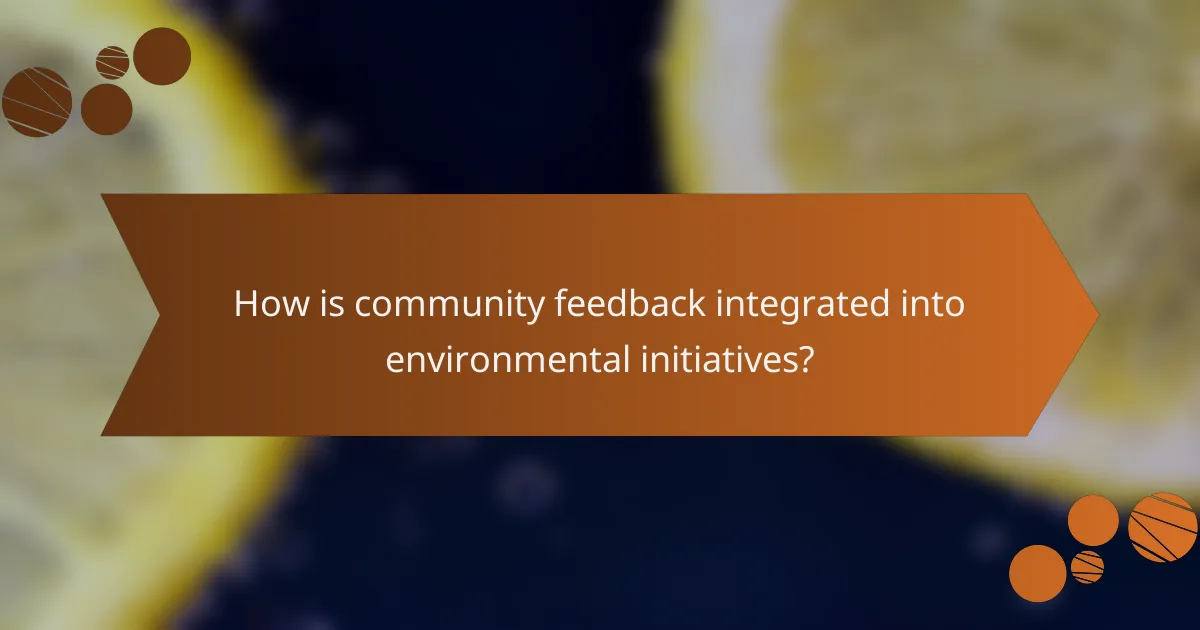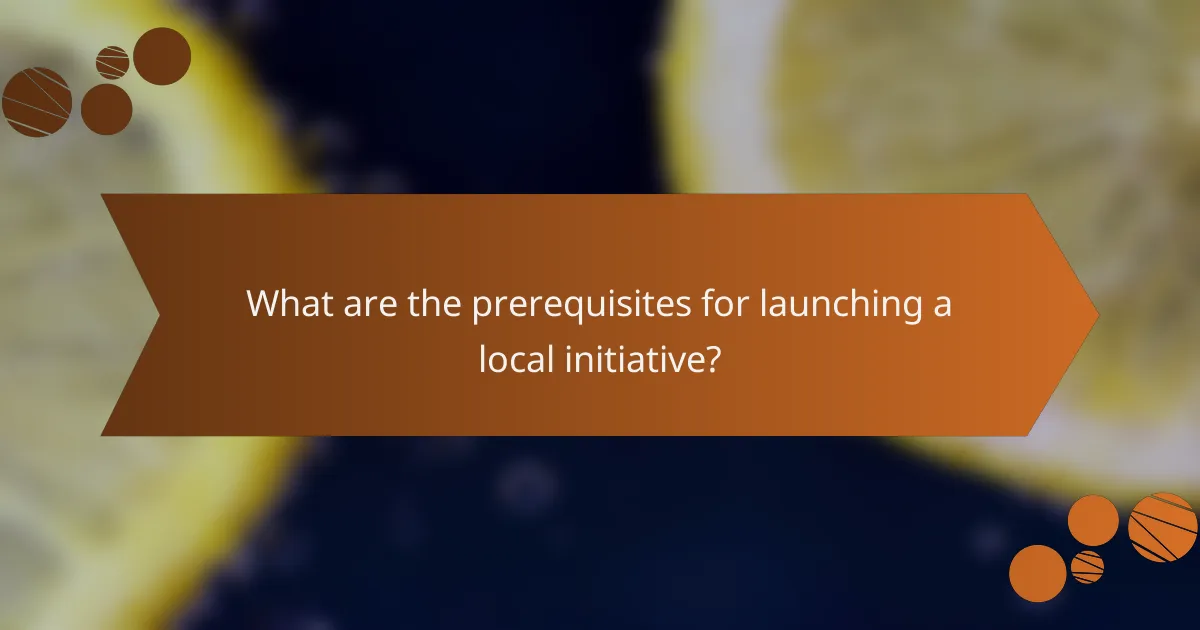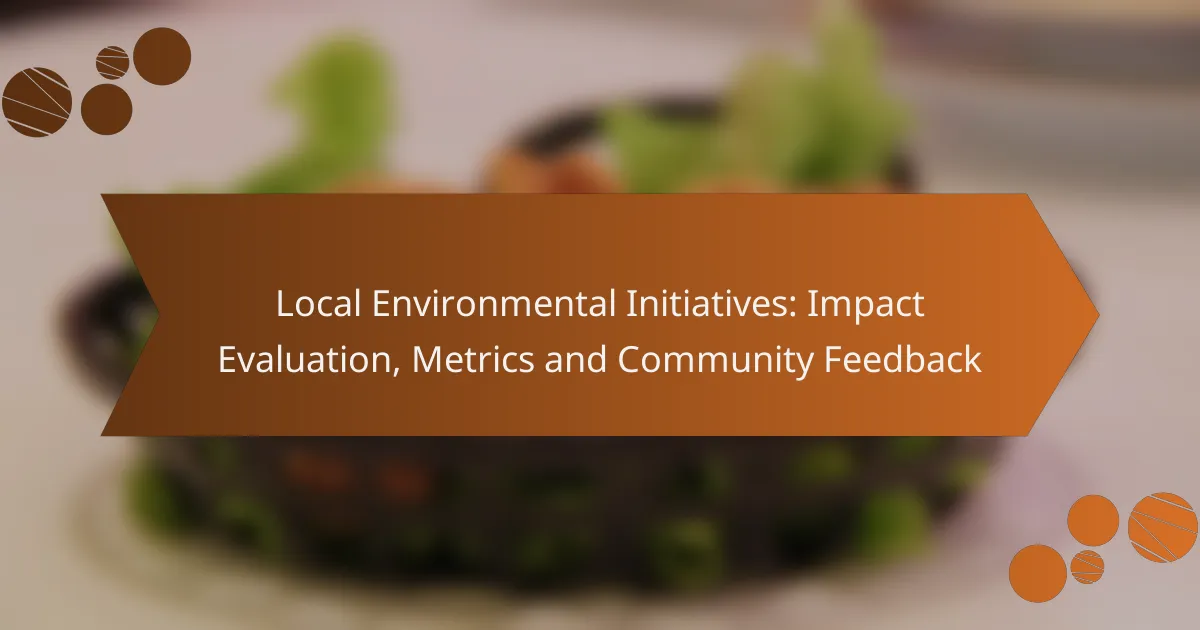Local environmental initiatives in Los Angeles aim to enhance sustainability and community health through targeted efforts in urban greening, waste reduction, renewable energy, water conservation, and pollution control. Evaluating the impact of these initiatives involves both quantitative and qualitative methods, allowing for a comprehensive assessment of their effectiveness and community engagement. Success is measured through various metrics, including reductions in carbon emissions, increases in green spaces, and community participation levels.

What are the local environmental initiatives in Los Angeles?
Los Angeles has implemented various local environmental initiatives aimed at enhancing sustainability and improving community health. These initiatives focus on urban greening, waste reduction, renewable energy, water conservation, and pollution control, all tailored to address the unique challenges of the region.
Urban greening programs
Urban greening programs in Los Angeles aim to increase green spaces, improve air quality, and enhance urban biodiversity. Initiatives include planting trees in neighborhoods, creating community gardens, and developing green roofs on commercial buildings.
These programs often involve partnerships with local organizations and residents, encouraging community participation. For instance, the city’s “Million Trees LA” initiative aimed to plant one million trees across the city, significantly contributing to urban canopy cover.
Waste reduction campaigns
Waste reduction campaigns in Los Angeles focus on minimizing landfill waste and promoting recycling. The city has implemented programs such as curbside recycling and composting, which help divert organic waste from landfills.
Residents are encouraged to participate through educational outreach and incentives. The “LA Recycles” campaign provides resources and information on proper recycling practices, aiming to increase the city’s recycling rate to over 70% in the coming years.
Community solar projects
Community solar projects in Los Angeles provide residents with access to renewable energy without the need for individual solar panel installations. These projects allow multiple households to benefit from a single solar array, reducing energy costs and promoting clean energy use.
Programs like the “Los Angeles Community Solar Program” offer financial incentives and support for low-income households, making solar energy more accessible. Participants can save on their utility bills while contributing to the city’s renewable energy goals.
Water conservation efforts
Water conservation efforts in Los Angeles are critical due to the region’s frequent droughts. The city promotes initiatives such as rebates for water-efficient appliances, drought-tolerant landscaping, and rainwater harvesting systems.
Programs like “Save Water LA” educate residents on water-saving practices and provide financial incentives for implementing water-efficient technologies. These efforts aim to reduce water consumption by significant percentages, helping to secure water resources for future generations.
Pollution control measures
Pollution control measures in Los Angeles focus on reducing air and water pollution through regulations and community initiatives. The city has implemented stricter emissions standards for vehicles and industrial operations to improve air quality.
Additionally, programs like the “Clean Up Green Up” initiative target pollution in disadvantaged neighborhoods, providing resources for community-led cleanup efforts. These measures aim to enhance public health and environmental quality across the city.

How do we evaluate the impact of these initiatives?
Evaluating the impact of local environmental initiatives involves a combination of quantitative and qualitative methods. These methods help assess effectiveness, community engagement, and overall sustainability outcomes.
Environmental metrics
Environmental metrics are quantitative measures that track changes in ecological conditions resulting from initiatives. Common metrics include air and water quality indices, biodiversity counts, and waste reduction percentages. For instance, a project aimed at reducing plastic waste may measure the decrease in plastic pollution in local waterways over time.
When selecting metrics, consider the specific goals of the initiative and the availability of data. Using standardized metrics can facilitate comparisons across different projects and regions.
Community surveys
Community surveys gather qualitative feedback from local residents about their perceptions of environmental initiatives. Surveys can assess awareness, satisfaction, and perceived effectiveness, providing insights into community engagement. For example, a survey might ask residents how much they value a new recycling program or their willingness to participate in local clean-up events.
To maximize response rates, keep surveys concise and ensure anonymity. Offering incentives, such as entry into a raffle, can also encourage participation.
Longitudinal studies
Longitudinal studies track environmental changes over extended periods, allowing for a deeper understanding of trends and long-term impacts. These studies can reveal whether initiatives lead to sustained improvements in environmental conditions or if changes are temporary. For instance, a study might monitor the health of a local forest ecosystem over several years after a conservation initiative is implemented.
Establishing a baseline before the initiative starts is crucial for effective longitudinal analysis. This helps in comparing future data to assess progress accurately.
Cost-benefit analysis
Cost-benefit analysis evaluates the economic feasibility of environmental initiatives by comparing the costs incurred with the benefits gained. This analysis can include direct costs, such as funding for projects, and indirect benefits, like improved public health or increased property values. For example, a city might analyze the costs of implementing a green space versus the benefits of reduced urban heat and enhanced community well-being.
When conducting a cost-benefit analysis, consider both tangible and intangible factors. Engaging stakeholders in the process can provide a broader perspective on the value of the initiative.

What metrics are used for measuring success?
Success in local environmental initiatives is typically measured using a variety of metrics that assess their effectiveness and impact. Key metrics include reductions in carbon emissions, increases in green spaces, community engagement levels, and water usage statistics.
Reduction in carbon emissions
Measuring reductions in carbon emissions is crucial for evaluating the effectiveness of environmental initiatives. This metric often involves comparing baseline emissions data with current figures to determine the impact of specific projects or policies.
For example, a community that implements a carpooling program may see a reduction in emissions by tracking the number of vehicles off the road. A reduction of 20-30% in emissions over a year can indicate significant progress.
Increase in green spaces
Green spaces are vital for enhancing urban environments and improving residents’ quality of life. Metrics for measuring increases in green spaces typically include the total area of parks, community gardens, or tree canopies added over a specific period.
Communities may aim for a target increase of 10-15% in green space within five years, which can be tracked through surveys or satellite imagery. Engaging local residents in planting initiatives can further enhance these metrics.
Community engagement levels
Community engagement levels reflect the active participation of residents in environmental initiatives. This can be measured through attendance at events, volunteer hours logged, or surveys assessing public awareness and involvement.
For instance, a successful initiative might aim for at least 50% of the community to participate in local clean-up events. Tracking these numbers helps gauge the initiative’s reach and effectiveness in fostering community spirit.
Water usage statistics
Water usage statistics are essential for assessing the sustainability of local environmental initiatives, especially in areas facing water scarcity. Metrics often include total water consumption, changes in usage patterns, and the effectiveness of water conservation programs.
Communities may set goals to reduce water usage by 10-20% over a few years, which can be monitored through utility data. Implementing rainwater harvesting systems can also contribute to these metrics by providing alternative water sources.

How is community feedback integrated into environmental initiatives?
Community feedback is crucial for shaping effective environmental initiatives. It ensures that projects align with local needs and priorities, fostering greater public support and participation.
Public forums
Public forums serve as a platform for community members to voice their opinions and concerns regarding environmental initiatives. These gatherings can take various forms, including town hall meetings and workshops, allowing for direct interaction between residents and project leaders.
To maximize participation, forums should be held at convenient times and accessible locations. Providing refreshments or incentives can also encourage attendance and engagement.
Feedback surveys
Feedback surveys are an effective tool for gathering structured input from the community. These surveys can be distributed online or in person, focusing on specific aspects of environmental initiatives, such as proposed projects or ongoing programs.
Surveys should be concise and user-friendly, ideally taking no more than 10 minutes to complete. Offering anonymity can increase response rates, as participants may feel more comfortable sharing honest feedback.
Partnerships with local organizations
Collaborating with local organizations enhances the integration of community feedback into environmental initiatives. These partnerships can facilitate outreach and help identify key community concerns that may not be immediately visible to project leaders.
Local organizations often have established trust within the community, making them valuable allies in promoting initiatives and gathering feedback. Engaging with these groups can lead to more comprehensive and inclusive environmental strategies.

What are the prerequisites for launching a local initiative?
Launching a local environmental initiative requires careful planning and consideration of several key factors. These include community involvement, securing funding, and ensuring compliance with relevant regulations.
Community involvement
Engaging the community is essential for the success of any local initiative. This can be achieved through public meetings, surveys, and collaboration with local organizations to gather input and foster support.
Consider forming a core group of volunteers or stakeholders who can champion the initiative. Their enthusiasm and local knowledge can significantly enhance outreach and participation.
Funding sources
Identifying funding sources is critical for sustaining an initiative. Potential funding can come from local government grants, non-profit organizations, or community fundraising events.
Explore partnerships with local businesses that may be willing to sponsor initiatives in exchange for positive publicity. Additionally, consider applying for environmental grants that support community projects.
Regulatory compliance
Compliance with local, state, and federal regulations is necessary to avoid legal issues. Research applicable environmental laws and permits that may be required for your initiative.
Consult with local government agencies or environmental organizations to ensure that your project aligns with existing regulations. This proactive approach can help streamline the approval process and enhance project credibility.
